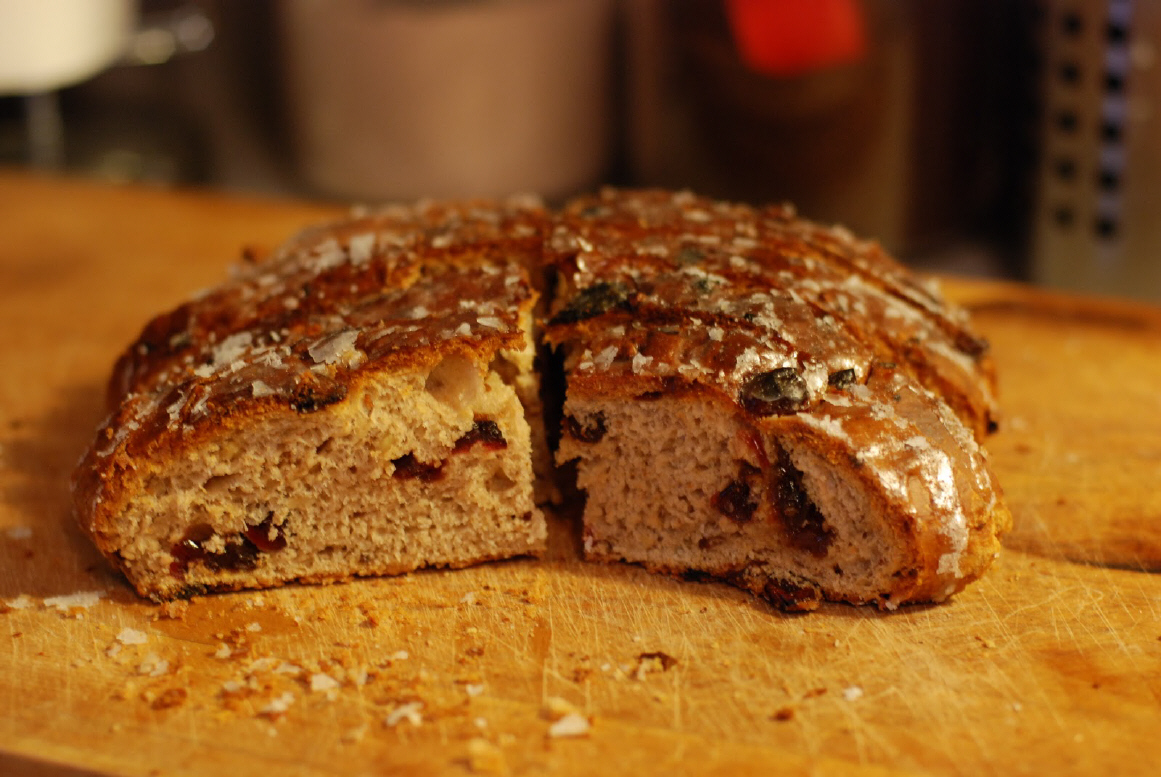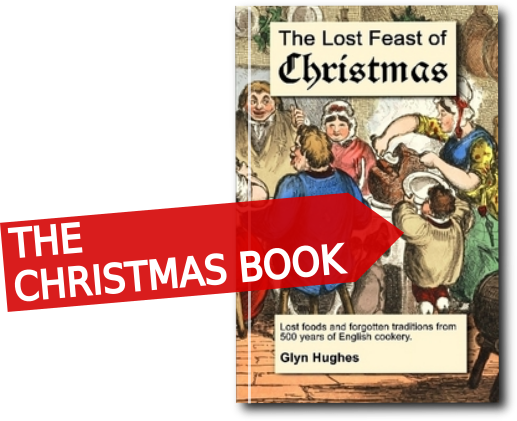

|
 (or Yule Cake) A very rich, yeast-raised white wheatflour bread cake, with lard, brown sugar, sweet spices, currants, egg, prepared for the winter festival.  Yule Bread Imege: http://domesticserviceeveryday.blogspot.co.uk These cakes may have formerly been made in the shape of a baby, perhaps to represent the birth of new life in the New Year. Walter Besant’s 1884 novel Dorothy Forster has; “The tables were covered with Yule-cakes, which are, in the north, shaped like a baby, and Christmas pies in form of a cradle.” John Brand’s Observations on popular antiquities of 1777 has; “The Yule-Dough … a Kind of Baby or little Image of Paste, which our Bakers used formerly to bake at this Season, and present to their Customers.” The compendium Telescope (1822, p298), says of village life in Yorkshire at year-end; “The yule candle is lighted, and a supper is served, of which one dish, from the lordly mansion to the humblest shed, is invariably furmety. Yule cake, one of which is always made for each individual in the family, and other more substantial viands are also added. Napier’s Folk-Lore of 1879 reports that; “Yule was a day of general preparation. Houses were cleaned out and borrowed articles were returned to their owners. Work of all kind was stopped, and a general appearance of completion of work was established; yarn was reeled off, no lint was allowed to remain on the rock of the wheel, and all work implements were laid aside. In the evening cakes were baked, one for each person, and duly marked, and great care was taken that none should break in the firing, as such an accident was a bad omen for the person whose cake met with the mishap. These cakes were eaten at the Yule breakfast. A large piece of wood was placed upon the fire in such time that it would be kindled before twelve p.m., and extreme care was taken that the fire should not go out, for not only was it unlucky, but no one would oblige a neighbour, with a kindling on Yule.”  Original Receipt from the ‘Leeds Mercury‘ – Saturday 19 December 1891 Original Receipt from the ‘Leeds Mercury‘ – Saturday 19 December 1891In the “Weekly Supplement” for November 28th, a lady correspondent asked for a recipe for Christmas bread. Did she want the kind we have in Cleveland, North Yorkshire, called Yell Cake or Yule Cake? If so, this is how our great-grandmothers made it, and how we make it every year. – Ingredients.— One stone of flour, four ounces of yeast, three pounds of butter or lard, three rounds of sugar, three pounds of currants, one pound and a half of raisins, half a pound of candied lemon peel, one ounce of cinnamon, one nutmeg grated, and one quart of milk, and a little salt. Method — Rub the butter or lard into the flour; than the salt, cinnamon., sugar, and nutmeg. Make a hole in the middle of the flour; stir in the milk (previously warmed) and the yeast; then cover the sponge with flour from the sides; stone the raisins, wash and clean the currants, cut the peel into strips, and put them round the sponge, and set it to rise in a warm place. When well risen knead all together, and divide into twenty pieces. Make each into a round loaf, place on a baking-tin, cross the top diamond-way with a two pronged fork. Let the loaves rise before the fire a few minutes then bake forty minutes. Our custom is to bake this quantity every year; each member of the family receives one on Christmas Day in the morning; others we send to relatives and friends. We make also a large better cake for visitors who call to taste the cheese – E. N.  Original Receipt from ‘King Edward’s Cookery Book‘, by Florence George of King Edward School, Birmingham, about 1901. Original Receipt from ‘King Edward’s Cookery Book‘, by Florence George of King Edward School, Birmingham, about 1901.Yule Cake, 3 lb. flour. 1 teaspoonfuls salt. 1 nutmeg. 1 lb. butter. 1 lb. sugar. 3 oz. yeast. 1 quart new milk (tepid). 2 or 3 eggs. 8 lb. sultanas, 1 lb. candied peel (Enough for 6 large cakes.) Put flour and grated nutmeg and salt into a warm basin, rub in the butter. Cream the yeast and a teaspoonful of sugar together, add milk and eggs well beaten, pour into the middle of the flour and work up well with a spoon. Leave to rise for an hour, and when well risen sprinkle over the sugar, sultanas, and peel; work in well by hand, and leave to rise again. Work up with a very little flour, and put into buttered bread-tins. Leave to rise again, and bake in a very hot oven. These cakes will keep for some time.   |
|
MORE FROM Foods of England... Cookbooks ● Diary ● Index ● Magic Menu ● Random ● Really English? ● Timeline ● Donate ● Royalty ● English Service ● Food Map of England ● Lost Foods ● Accompaniments ● Biscuits ● Breads ● Cakes and Scones ● Cheeses ● Classic Meals ● Curry Dishes ● Dairy ● Drinks ● Egg Dishes ● Fish ● Fruit ● Fruits & Vegetables ● Game & Offal ● Meat & Meat Dishes ● Pastries and Pies ● Pot Meals ● Poultry ● Preserves & Jams ● Puddings & Sweets ● Sauces and Spicery ● Sausages ● Scones ● Soups ● Sweets and Toffee ● About ... ● Bookshop ● Email: [email protected] COPYRIGHT and ALL RIGHTS RESERVED: © Glyn Hughes 2022 BUILT WITH WHIMBERRY |